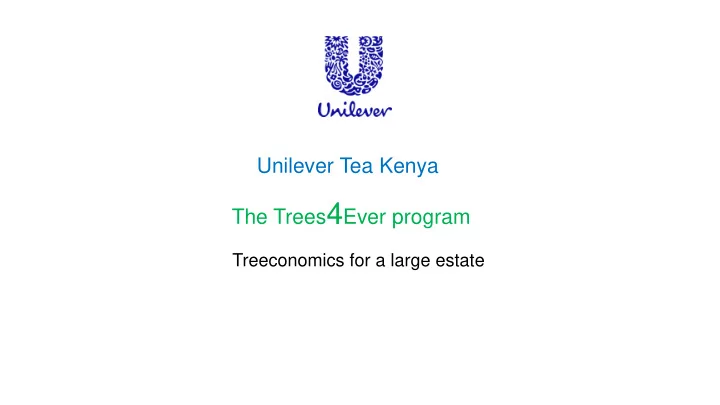

Unilever Tea Kenya The Trees 4 Ever program Treeconomics for a large estate
Unilever Tea Kenya Plantation – the location Airstrips
Unilever Tea Kenya – Key figures Hectares Production • Tea 8250 160000t of Green leaf • 36000t black tea per year • Eucalyptus 1800 126,000 cbm/yr Indigenous forest & 1400 Ecological services conservation areas
Unilever sustainable living plan - USLP Improving Health & Well- Reducing Environmental Enhancing Livelihoods being Impact BETTER HEALTH & SUSTAINABLE GREENHOUSE NUTRITION WASTE WATER LIVELIHOODS HYGIENE SOURCING GASES Unilever is a is a leader in sustainability – our Tree4Ever program is in line wit h the USLP initiative
Forest value - The Biomass need • UTK uses 126,00 0 cubic metres of firewood annually ( to provide 846 K GJ) • This supply sufficient energy to 8 tea factories • Eucalyptus provides a reliable source of biomass – fast growing, easy to split & feed boilers + High calorific value • A sustainable model – aim is for a carbon neutral business: sequester as much or more than you emit • We’ve tried Bamboo & Croton but found Eucalyptus to accumulate biomass faster per unit of input. Nominal cost Over KES 220M firewood per annum
Eucalyptus forest – seeds and varieties • Mainly planting E.grandis . There are also pockets of E. saligna, E. paniculata and hybrids of these species • We’ve tested some species from S. Africa Ultimate Biomass @ yr 8 but found own species to perform better in biomass accumulation. • Seeds are collected from the best trees within a plantation and planted out in the nursery • Mass seed planting is done then selection is done in the nursery based on seedling vigour • Continous mass selection over the years results in improved and uniform stand Seedling height & vigour @ 1month
The Trees4Ever program Objective: Environmental conservation and improvement Activities • Develop indigenous trees nurseries and grow indigenous trees • Improve biodiversity – consciously enrich the diversity within the conservation areas – currently planting over 69 different species ( mainly species within the Mau catchment area) • Promote environmental conservation awareness and sustainability - Participatory approach to conservation
The Trees4Ever program – seeds & seedlings • We plant species that thrive in the locality we operate – over 69 different species • We link with community collectors to provide wildlings – source of income to the community • We support community nurseries through our CSR program – purchase of seedling T his year we’ve propagated from community over 650K seedlings. nurseries. • Our arboreta and biodiversity islands are also source of seed. • We purchase from KFS
Unilever Tea Kenya Trees4Ever planting Progress - cumulative totals as at December 2014 1200000 1100000 1000000 900000 800000 700000 600000 500000 400000 300000 200000 100000 0 Pre-2003 2003 2004 2005 2006 2007 2008 2009 2010 2011 2012 2013 2014 Local community WWF & UNEP Schools & Churches Egerton Employees Outgrowers Sales Company land
Forest value – other Ecological services Water • The entire UTK’s 8250 ha of tea and 1800ha of Eucalyptus is rainfed ( not irrigation is used) • The rain received is convectional – modulated by the Mau forest and the localities forest areas • All water used for domestic and cleaning is from the local rivers Pest & disease management • UTK does not use any pesticides to control pests & disease. • This is attributed to a healthy environment with a good presence of natural enemies to keep potential pests at check
Forest value – other Ecological services Hydro electricity • Indigenous forests within the catchment regulate river water volume – enhance recharge of aquifers • UTK generates 2800 Kw of electricity from the four hydro turbines • Out of the four, three turbines are on the on a single river traversing the plantation. Over£340M saved on electricity
Forest value – other Ecological services Arboreta, aesthetics and community culture & customs • UTK has created several recreational packs and arboreta A study by the • National Museums Two main ones are open to the public and they are areas for of Kenya scientists educational, recreation and found 174 different research purposes. species of birds – • most were forest Conservation of species of dependent species! value (resonance) to the cultures within our locality Given the focus on Biodiversity cash agriculture & • Our conservation efforts has diminished also contributed to improvement in biodiversity. biodiversity within Rare animals e.g clawless the rural farmlands, otters, and the population of the UTK forests the colour colobus monkeys provide a haven for has notably increase. pollinators • Just commissioned NMK to supporting farmers undertake a biodiversity study
Rainfall trends in Kericho RAINFALL 3000 TOTAL RAINFALL (MM) 2800 2600 2400 2200 2000 1800 1600 1400 y = -4.8249x + 11673 R² = 0.0474 1200 1000 1950 1960 1970 1980 1990 2000 2010 2020 YEAR
Mean air temperatures 16.6 16.4 Temperature ( 0 C) 16.2 16 y = 0.2x + 15.508 R² = 0.8524 15.8 15.6 1969 1979 1989 1999 2009 Years
Challenges • Tree survival especially on outreach areas : Framework for care & maintenance especially in public areas with no jurisdiction • Unsustainable harvesting & poaching – debarking and harvesting for herbal ingredients and ceremonies • Challenges of climate change – increased incidences of pest and disease on newly established forests. Diminished survival due to unfavourable climate. • Costs of running the nurseries and maintenance • Winning the public goodwill – building an effective participatory approach to conservation and care. • Insufficient research on conservation forestry and natural resource management.
Thank you
Recommend
More recommend